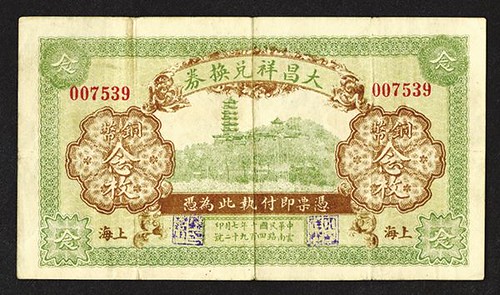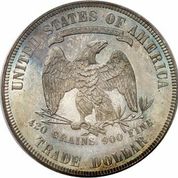
PREV ARTICLE
NEXT ARTICLE
FULL ISSUE
PREV FULL ISSUE
TRADE DOLLARS IN OREGON 1875-1876
An article by Jim Laughlin in the June 2016 issue of The E-Gobrecht (a publication of the Liberty Seated Collectors Club) reprints
some interesting articles on the use and circulation of U.S. Trade Dollars from contemporary Oregon newspapers published in 1875 and
1876. Here's an excerpt. -Editor
Here in late May 1876, the Treasurer indicates “... that people generally paid their taxes this year in silver”.....and that, “...3⁄4 of all the taxes paid into the Treasury of Clatsop county, was silver and a very material proportion of that was Trade Dollars.” Of note, the Treasurer has qualified his statement by using the wording that most individuals paid their taxes in silver “this year.” Thus making a distinction that taxes in previous years were paid differently, and that meant gold coin. Legal Tender paper currency likely was not accepted by the County Government, any one holding such notes had to go to a brokerage house of bank and exchange the paper notes for gold or silver coin at a steep discount. The financial page in the same paper indicates you could get 88 cents per paper dollar. Trade dollars were expected to have been exported and used in trade with the Orient, but the law creating them had also included the provision that they were legal tender domestically in amounts up to $5. This matched the same legal tender limits that applied to the silver subsidiary coin (i.e. half, quarter, 20c, dime, and half-dime). Gold coin was legal tender in any amounts, but people could refuse to accept silver coin in amounts greater than $5. There was however a distinct difference between trade dollars and subsidiary silver coin. Subsidiary silver coin was only supposed to be obtainable from the Government by exchanging gold coin for them, whereas, anyone holding silver bullion could take that bullion to the Mint and have it converted into trade dollars, 378 grains of pure silver to a coin, and pay a nominal “minting charge,” which was required to be the actual cost the Mint expended to coin the bullion received, and walk away with a dollar coin that was legal tender up to $5. What had happened since the trade dollars were created in 1873, silver bullion prices (priced in gold coin) had declined so much, that the cost of 378 grains of silver along with the nominal minting charge to coin a single trade dollar coin, was actually less than the dollar face value that the coin would bring in domestic circulation. Thus, people that had access to silver bullion and were in the know, started taking their bullion to the Mint and having it converted into trade dollars, spending them domestically. Thus making a profit on each coin spent. Carothers in his book Fractional Currency, indicates that the tipping point occurred with the price of silver in early 1876, and by the middle of 1876, trade dollar coins were flooding retail trade in California. For more information on the Liberty Seated Collectors Club, see:

Archives International Auctions, Part XXXIII Chinese, Asian &Worldwide Banknotes, and Chinese Scripophily June 28, 2016 
Click the links! Highlights include: Lot 198: American-Oriental Banking Corporation, 1919 “Shanghai Branch” Lot 245: Dah Chon Chang Money Exchange, ca.1920's "Shanghai" Lot 315: Republik Indonesia Unlisted 1948 Issue Essay Specimen Lot 451: Banco de Portugal - Azores. 1909 Issue Lot 475: Imperial Do Brazil (1882) Issue Color Trial Essay Proof Lot 700: Comite Bancario de Guatemala. 1899 Issue Lot 889: Bank of Rhodesia & Nyasaland. 1960 Issue. Lot 1006: Central Bank of Turkey. 1930 Law Issue View the Virtual Catalog Download the Catalog in PDF format ARCHIVES INTERNATIONAL AUCTIONS, LLC 1580 Lemoine Avenue, Suite #7 Fort Lee, NJ 07024 Phone: 201-944-4800 Email: info@archivesinternational.com WWW.ARCHIVESINTERNATIONAL.COM Wayne Homren, Editor The Numismatic Bibliomania Society is a non-profit organization promoting numismatic literature. See our web site at coinbooks.org. To submit items for publication in The E-Sylum, write to the Editor at this address: whomren@gmail.com To subscribe go to: https://my.binhost.com/lists/listinfo/esylum All Rights Reserved. NBS Home Page Contact the NBS webmaster 
|
